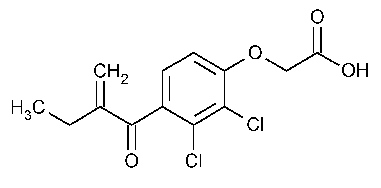Ethacrynic Acid
Acetic acid,[2,3-dichloro-4-(2-methylene-1-oxobutyl)phenoxy]-.
[2,3-Dichloro-4-(2-methylenebutyryl)phenoxy]acetic acid [58-54-8].
»Ethacrynic Acid contains not less than 97.0percent and not more than 102.0percent of C13H12Cl2O4,calculated on the dried basis.
Caution—Use care in handling Ethacrynic Acid,since it irritates the skin,eyes,and mucous membranes.
Packaging and storage—
Preserve in well-closed containers.Store at 25 ,excursions permitted between 15
,excursions permitted between 15 and 30
and 30 .
.
Identification—
A:Infrared Absorption á197Mñ.
B:Ultraviolet Absorption á197Uñ—
Solution:
50µg per mL.
Medium:
methanol.
Absorptivities at 271nm,calculated on the dried basis,do not differ by more than 3.0%.
C:
Add 2mLof 1Nsodium hydroxide to about 25mg of it,and heat for several minutes in a boiling water bath.Cool the solution,acidify with 0.25mLof 18Nsulfuric acid,add 0.5mLof chromotropic acid sodium salt solution (1in 10),then add,cautiously,2mLof sulfuric acid TS:a deep violet color is produced.
Loss on drying á731ñ—
Dry it at a pressure not exceeding 5mm of mercury at 60 for 2hours:it loses not more than 0.25%of its weight.
for 2hours:it loses not more than 0.25%of its weight.
Residue on ignition á281ñ:
not more than 0.1%.
Toluene extractives—
Accurately weigh about 1g into a glass-stoppered,100-mLcylinder.Add 50mLof sodium sulfite solution (2in 25),and agitate until the solid dissolves.Allow to stand for 20minutes,add 5mLof hydrochloric acid,and mix.Divide the solution between two centrifuge tubes,each of which contains 15mLof toluene.Close each tube tightly,using a polyethylene stopper,and shake vigorously during 2minutes,occasionally relieving the pressure from the sulfur dioxide by loosening the stoppers.Centrifuge the tubes,withdraw most of the upper layer by means of a syringe,avoiding withdrawal of any of the lower,aqueous phase,and transfer the toluene extracts to a tared evaporating dish.Repeat the extraction twice with additional 15-mLportions of toluene,and evaporate the combined extracts on a steam bath to dryness.Dry the residue at a pressure not exceeding 5mm of mercury at 60 for 2hours.Cool,and weigh:not more than 2.0%of extractives is found.
for 2hours.Cool,and weigh:not more than 2.0%of extractives is found.
Equivalent weight—
Dissolve about 400mg,accurately weighed,in 100mLof methanol,add 5mLof water,and titrate with 0.1Nsodium hydroxide VS,determining the endpoint potentiometrically,using a calomel–glass electrode system.Perform a blank determination,and make any necessary correction.Calculate the equivalent weight on the dried basis:it is between 294and 309.
Heavy metals,Method IIá231ñ:
0.001%.
Organic volatile impurities,Method Vá467ñ:
meets the requirements.
Solvent—
Use dimethyl sulfoxide.
Assay—
Dissolve about 100mg of Ethacrynic Acid,accurately weighed,in 20mLof glacial acetic acid in an iodine flask.Pipet 20mLof 0.1Nbromine VSinto the flask,add 3mLof hydrochloric acid,immediately insert the stopper,and seal the flask with a few mLof water in the stopper well.Swirl the flask,and allow to stand in the dark for 1hour.Add 50mLof water and 15mLof potassium iodide TS,and immediately titrate with 0.1Nsodium thiosulfate VS,adding 2.0mLof starch TSas the endpoint is approached.Perform a blank determination (see Residual Titrationsunder Titrimetry á541ñ).Each mLof 0.1Nbromine is equivalent to 15.16mg of C13H12Cl2O4.
Auxiliary Information—
Staff Liaison:Andrzej Wilk,Ph.D.,Senior Scientific Associate
Expert Committee:(PA5)Pharmaceutical Analysis 5
USP28–NF23Page 784
Pharmacopeial Forum:Volume No.29(5)Page 1479
Phone Number:1-301-816-8305
